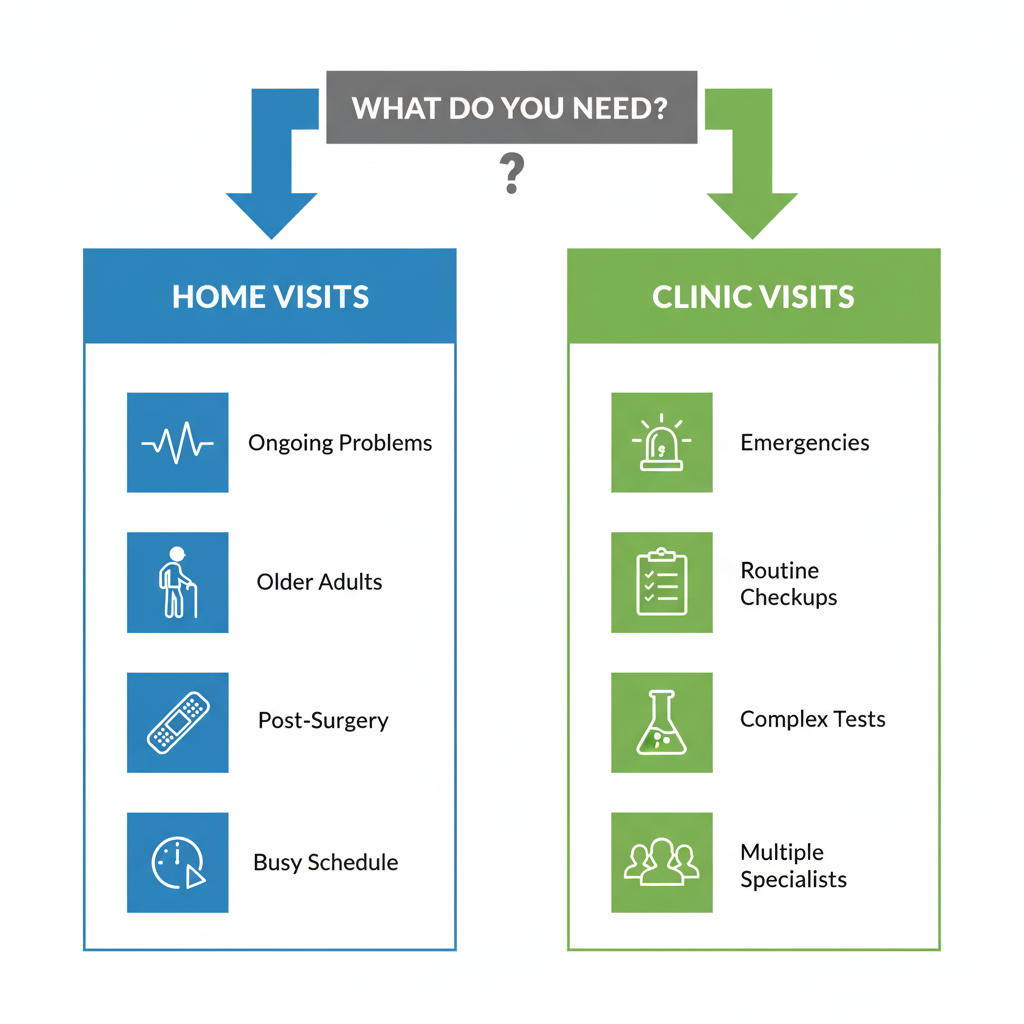Healthcare costs matter. When you need medical care, you have two main choices. You can visit a doctor's clinic or have a doctor visit your home. Each option costs different amounts of money.
This guide helps you understand both choices. We'll look at what each costs and when each makes sense. You'll learn how to pick the best option for your needs and budget.
Home Visits vs Clinic Visits: The Basics
Healthcare comes in two main types today.
Home Visits: A doctor or nurse comes to your house. They bring medical equipment and provide care in your own space. This works well for people who have trouble getting around.

Clinic Visits: You go to a medical office or hospital. The clinic has all the equipment and staff in one place. Most people are used to this type of care.
Both options help you stay healthy. The trick is knowing which costs less for your situation.
Why Costs Matter When Choosing Care
Money plays a big role in healthcare decisions. Each type of visit has different expenses.
Home visits often cost more up front. The doctor charges for travel time and gas. But you save money on your own travel costs. You also save time off work.
Clinic visits usually have set prices. But you might pay for parking, gas, or taking time off work. Some people also need someone to drive them.
Think about all these costs when making your choice. The cheapest option isn't always obvious at first glance.
What Affects Home Visit Prices
Several things change how much a home visit costs:
Distance matters most. Doctors charge more if they travel far to reach you. A visit across town costs more than one nearby.
The type of care changes prices too. A simple check-up costs less than specialized treatment. Complex procedures need more equipment and time.
The doctor's experience level affects cost. More experienced doctors often charge higher fees. But they might solve problems faster.
Ask about all fees before booking. Some doctors charge separately for travel while others include it in their base price.
%20(1).png)
Benefits That Make Home Visits Worth It
Home visits cost more but offer real value:
You don't waste time traveling or sitting in waiting rooms. This saves money if you would lose work time.
You get personal attention. The doctor focuses only on you. There are no distractions from other patients.
You avoid getting sick from other patients. Clinics can spread germs. This matters a lot if your immune system is weak.
Your family can be there during the visit. This helps with understanding treatment plans and asking questions.
When Home Visits Save Money
Home visits work best in these cases:
Ongoing health problems: Regular visits can prevent expensive hospital stays. Early treatment costs less than emergency care.
Older adults: Seniors often find travel difficult and expensive. Home care lets them stay comfortable while getting quality treatment.
After surgery: Recovery goes better at home. Frequent check-ups are easier when the doctor comes to you.
Busy schedules: If taking time off work costs a lot, home visits can be cheaper overall.
Understanding Clinic Costs
Clinics price their services differently than home visits.
Most clinics charge set fees for different services. A basic visit might cost $150. Lab tests add extra charges. These prices don't usually change much.
Many insurance plans cover clinic visits better than home visits. Your out-of-pocket cost might be lower at a clinic.
Clinics can handle emergencies quickly. They have equipment and staff ready. This can prevent small problems from becoming expensive ones.
.png)
When Clinics Make More Financial Sense
Choose clinic visits in these situations:
Emergencies: Fast treatment prevents bigger problems and higher costs later.
Routine check-ups: Standard visits have predictable prices. Insurance usually covers these well.
Complex tests: Clinics have expensive equipment on-site. Using it there costs less than having it brought to your home.
Multiple specialists: Seeing several doctors in one trip saves time and travel costs.
Direct Cost Comparison
Let's look at actual numbers:
Home Visit Costs:
- Doctor fee: $200-400
- Travel charge: $50-100
- Your costs: $0 for travel

Clinic Visit Costs:
- Doctor fee: $150-250
- Your travel: $20-50
- Time off work: $50-200
- Parking: $10-20
The total cost depends on your specific situation. Home visits cost more upfront but might save you money in other ways.
Hidden Costs You Need to Know
Both options have costs you might not think about:
Time costs matter. Home visits save your time but use the doctor's travel time. Clinic visits might involve long waits.
Health outcomes affect long-term costs. Easy access to care helps catch problems early. This prevents expensive treatments later.
Stress and comfort have value too. Being comfortable might help you heal faster or stick to treatment plans better.
Insurance and Your Wallet
Your insurance plan changes everything. Many plans cover clinic visits fully but only pay part of home visit costs.
Check these details:
- Does your plan cover home visits?
- What's your copay for each option?
- Are there limits on how many visits you can have?
Call your insurance company before deciding. Get clear answers about what you'll pay out of pocket.
Geographic Differences in Pricing
Where you live affects healthcare costs a lot.
City areas often have more doctors offering home visits. Competition can keep prices lower. But traffic might increase travel charges.
Rural areas might have fewer home visit options. This can make prices higher. But clinic visits might also cost more due to less competition.
Wealthy neighborhoods typically see higher prices for all medical services.
Research local prices before making healthcare plans. Costs can vary widely even within the same city.
Making Smart Healthcare Decisions
Choose based on your real needs:
Think about your health condition. Serious problems might need clinic equipment. Routine care can often happen at home.
Consider your mobility. If getting around is hard, home visits make sense despite higher costs.
Look at your schedule. Busy people often save money overall with home visits.
Check your budget. Make sure you can afford your choice without financial stress.
Planning Your Healthcare Budget
Smart planning helps you afford good care:
Set aside money each month for medical expenses. Even with insurance, you'll have some out-of-pocket costs.
Use health savings accounts if available. These let you pay for medical care with pre-tax dollars.
Compare prices from different providers. Costs can vary significantly for the same service.
Don't skip care to save money. Early treatment usually costs much less than waiting until problems get worse.
Making the Right Choice for You
The best healthcare option balances quality and cost. Think about your specific situation:
- How often do you need medical care?
- Can you easily get to a clinic?
- What does your insurance cover?
- How much time can you spend on healthcare visits?
There's no single right answer for everyone. What matters is finding what works for your health needs and budget.
Final Thoughts
Both home visits and clinic visits have their place in healthcare. Home visits offer convenience and personal attention but cost more upfront. Clinic visits provide predictable pricing and quick access to equipment.
Your choice should fit your health needs, lifestyle, and budget. Don't just pick the cheapest option - think about total value including your time and comfort.
Dr. Morepen Home offers quality home healthcare solutions designed around your needs. Whether you choose home or clinic care, the most important thing is getting the medical attention you need.
Good healthcare decisions balance cost with quality. Take time to understand your options. Your health and your wallet will thank you for making informed choices.
FAQ
Does insurance cover home visits?
Many insurance plans do cover home visits, but coverage varies. Check with your insurance company to see what's included in your plan. Some plans pay the full cost while others only cover part of it.
Is it cheaper to visit a clinic or have a doctor come home?
It depends on your situation. Clinic visits often have lower upfront costs, but you might spend money on travel and time off work. Home visits cost more initially but can save you money in other ways. Look at your total costs, not just the doctor's fee.
How do emergency visits change the cost comparison?
Emergency care usually costs more no matter where you get it. Clinics can handle emergencies faster because they have equipment and staff ready. For true emergencies, speed matters more than cost.
What makes Dr. Morepen Home different from clinic visits?
Dr. Morepen Home brings personalized medical care to your home. You get focused attention without waiting rooms or travel time. This can be especially valuable for people with mobility issues or busy schedules.
Does where I live affect healthcare costs?
Yes, location makes a big difference in healthcare prices. Urban areas might have more competition, which can lower prices. Rural areas might have fewer options, which can raise costs. Research local prices when planning your healthcare budget.
.png)



.png)
.png)
.png)
.png)
.png)
.png)
.png)

.png)
.png)
.png)

.png)
.png)
.png)
.png)
.png)
.png)

.png)
.png)

.png)
.png)
.png)

.png)

.png)


.png)







